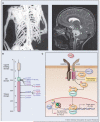ACVR1 mutations in DIPG: lessons learned from FOP
- PMID: 25136070
- PMCID: PMC4154859
- DOI: 10.1158/0008-5472.CAN-14-1298
ACVR1 mutations in DIPG: lessons learned from FOP
Abstract
Whole-genome sequencing studies have recently identified a quarter of cases of the rare childhood brainstem tumor diffuse intrinsic pontine glioma to harbor somatic mutations in ACVR1. This gene encodes the type I bone morphogenic protein receptor ALK2, with the residues affected identical to those that, when mutated in the germline, give rise to the congenital malformation syndrome fibrodysplasia ossificans progressiva (FOP), resulting in the transformation of soft tissue into bone. This unexpected link points toward the importance of developmental biology processes in tumorigenesis and provides an extensive experience in mechanistic understanding and drug development hard-won by FOP researchers to pediatric neurooncology. Here, we review the literature in both fields and identify potential areas for collaboration and rapid advancement for patients of both diseases.
©2014 American Association for Cancer Research.
Figures

Similar articles
-
Shared ACVR1 mutations in FOP and DIPG: Opportunities and challenges in extending biological and clinical implications across rare diseases.Bone. 2018 Apr;109:91-100. doi: 10.1016/j.bone.2017.08.001. Epub 2017 Aug 2. Bone. 2018. PMID: 28780023 Free PMC article.
-
Effects of FKBP12 and type II BMP receptors on signal transduction by ALK2 activating mutations associated with genetic disorders.Bone. 2018 Jun;111:101-108. doi: 10.1016/j.bone.2018.03.015. Epub 2018 Mar 15. Bone. 2018. PMID: 29551750
-
Midline brain hamartomatous lesions in fibrodysplasia ossificans progressiva with ACVR1 mutations.Neuropathology. 2023 Aug;43(4):333-339. doi: 10.1111/neup.12892. Epub 2023 Jan 15. Neuropathology. 2023. PMID: 36642816 Review.
-
Common mutations in ALK2/ACVR1, a multi-faceted receptor, have roles in distinct pediatric musculoskeletal and neural orphan disorders.Cytokine Growth Factor Rev. 2016 Feb;27:93-104. doi: 10.1016/j.cytogfr.2015.12.007. Epub 2015 Dec 28. Cytokine Growth Factor Rev. 2016. PMID: 26776312 Free PMC article. Review.
-
Recurrent activating ACVR1 mutations in diffuse intrinsic pontine glioma.Nat Genet. 2014 May;46(5):457-461. doi: 10.1038/ng.2925. Epub 2014 Apr 6. Nat Genet. 2014. PMID: 24705252 Free PMC article.
Cited by
-
Discovery of Highly Potent and BMPR2-Selective Kinase Inhibitors Using DNA-Encoded Chemical Library Screening.J Med Chem. 2023 Feb 9;66(3):2143-2160. doi: 10.1021/acs.jmedchem.2c01886. Epub 2023 Jan 31. J Med Chem. 2023. PMID: 36719862 Free PMC article.
-
Targeting ALK2: An Open Science Approach to Developing Therapeutics for the Treatment of Diffuse Intrinsic Pontine Glioma.J Med Chem. 2020 May 14;63(9):4978-4996. doi: 10.1021/acs.jmedchem.0c00395. Epub 2020 May 5. J Med Chem. 2020. PMID: 32369358 Free PMC article.
-
Pediatric diffuse midline glioma: Understanding the mechanisms and assessing the next generation of personalized therapeutics.Neurooncol Adv. 2023 Apr 12;5(1):vdad040. doi: 10.1093/noajnl/vdad040. eCollection 2023 Jan-Dec. Neurooncol Adv. 2023. PMID: 37152806 Free PMC article. Review.
-
ALK2 Receptor Kinase Association with FKBP12.6 Is Structurally Conserved with the ALK2-FKBP12 Complex.Biomedicines. 2021 Jan 29;9(2):129. doi: 10.3390/biomedicines9020129. Biomedicines. 2021. PMID: 33572801 Free PMC article.
-
Cardiopulmonary and Neurologic Dysfunctions in Fibrodysplasia Ossificans Progressiva.Biomedicines. 2021 Feb 5;9(2):155. doi: 10.3390/biomedicines9020155. Biomedicines. 2021. PMID: 33562570 Free PMC article. Review.
References
Publication types
MeSH terms
Substances
Grants and funding
LinkOut - more resources
Full Text Sources
Other Literature Sources

